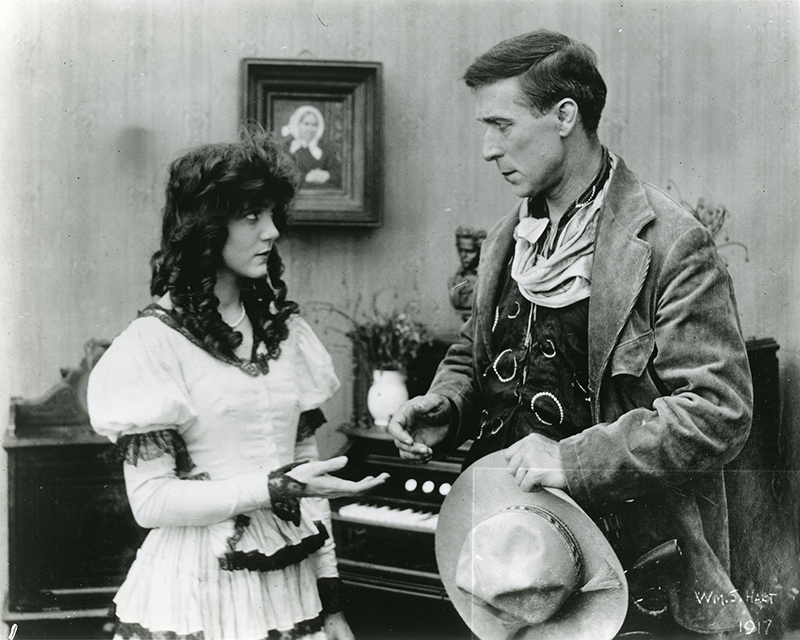|
|


Click image to enlarge
Margery Wilson and William S. Hart are featured in 1916's "The Return of Draw Egan," widely considered one of Hart's best films. The same ubiquitous publicity image was used in the promotional lantern slide. The meaning of the 1917 date, evidently written on the film negative, is unknown. The movie premiered October 15, 1916, in the United States, and in 1918 in Europe.
About "The Return of Draw Egan" From Koszarski (1980:53): Produced by Triangle/Kay-Bee under the supervision of Thomas H. Ince; distributed by Triangle; in production April 29-May 24, 1916; released October 15, 1916; © as a reissue by Tri-Stone Pictures, May 25, 1924; production cost, $13,307.65; also known as "The Fugitive;" five reels. Directed by William S. Hart; story and screenplay by C. Gardner Sullivan; photographed by Joe August; art director, Robert Brunton; assistant director, Cliff Smith. CAST: William S. Hart ("Draw" Egan/William Blake); Louise Glaum (Poppy); Margery Wilson (Myrtle Buckton); Robert McKim (Arizona Joe); J.P. Lockney (Mat Buckton). SYNOPSIS: With a price of a thousand dollars on his head, "Draw" Egan, captain of a band of outlaws, escapes with Arizona Joe from a burning cabin in which he is cornered. They separate. The impression goes forth that "Draw" Egan is slain. Yellow Dog is a town wherein the bad element has been running things with a high hand. The reformers under Mat Buckton cast about for a fearless man to rule the community. When "Draw" Egan shows up on the horizon he attracts the attention of Mat Buckton, who persuades him to take the position of sheriff. "Draw" takes him up. Yellow Dog soon shows the effect of his iron rule. Law and order prevail. Arizona Joe shows up about this time and pretends to be a fearless desperado. He discovers "Draw" Egan's position in the community and hears from his former chief that no mischief will be tolerated. Spurred on to make trouble by Poppy, the dance-hall queen, Arizona Joe defies "Draw" Egan and the latter fails to check him, for he has fallen in love with Myrtle Buckton. Finally the terrible fear of "Draw" Egan which had up to this time checked the bad men of the community, is dissipated. Word is passed to the community by Arizona Joe that certain leaders of the respectable must leave town. "Draw" Egan accepts Arizona Joe's defie, permits the exposure of his past, arranges a duel with him at sunset, and without firing a shot while his opponent drives away at him with his gun, "Draw" frightens him out of town. He then surrenders himself up for punishment, but the community forgives his past, and appoints him sheriff to the delight of Myrtle Buckton. ["Return of Draw Egan" pressbook, 1916.] REVIEW: "Draw" Egan is an outlaw, and one apparently without other preparation for a place in the civilized world than his daring, his physical strength and his skill in handling deadly weapons. Chance favors him at a time when his desperate career reaches the inevitable end. An incident ... reveals his command over the fear forces in men to a leading citizen ... who is in search of a man to act as sheriff ... he accepts the position as an escape from the very forces he is thereafter bound to maintain. ... The outlaw's sense of duty is not established by the responsibilities of his new position in life, but through the sentimental side of his character: he falls in love with the daughter of his benefactor. ... [There] is a powerful appeal to compassion of the intelligent kind, a commiseration that reasons from experience and from knowledge of human nature. [Louis Reeves Harrison, Moving Picture World, September 30, 1916.]
LW3194: 9600 dpi jpeg from 8x10 copy print purchased 2018 by Leon Worden.
|
WATCH FULL MOVIES
Biography
(Mitchell 1955)
Narrated Biopic 1960
Biography (Conlon/ McCallum 1960)
Biography (Child, NHMLA 1987)
Essay: The Good Bad Man (Griffith & Mayer 1957)
Film Bio, Russia 1926
The Disciple 1915/1923
The Captive God 1916 x2
The Aryan 1916 x2
The Primal Lure 1916
The Apostle of Vengeance (Mult.)
Return of Draw Egan 1916 x2
Truthful Tulliver 1917
The Gun Fighter 1917 (mult.)
Wolf Lowry 1917
The Narrow Trail 1917 (mult.)
Wolves of the Rail 1918
Riddle Gawne 1918 (mult.)
"A Bullet for Berlin" 1918 (4th Series)
The Border Wireless 1918 (Mult.)
Branding Broadway 1918 x2
Breed of Men 2-2-1919 Rivoli Premiere
The Poppy Girl's Husband 3-23-1919 Rivoli Premiere
The Money Corral 4-20-1919 Rialto Premiere
Square Deal Sanderson 1919
Wagon Tracks 1919 x3
Sand 1920 Lantern Slide Image
The Toll Gate 1920 (Mult.)
The Cradle of Courage 1920
The Testing Block 1920:
Slides, Lobby Cards, Photos (Mult.)
O'Malley/Mounted 1921 (Mult.)
The Whistle 1921 (Mult.)
White Oak 1921 (Mult.)
Travelin' On 1921/22 (Mult.)
Three Word Brand 1921
Wild Bill Hickok 1923 x2
Singer Jim McKee 1924 (Mult.)
"Tumbleweeds" 1925/1939
Hart Speaks: Fox Newsreel Outtakes 1930
|
The site owner makes no assertions as to ownership of any original copyrights to digitized images. However, these images are intended for Personal or Research use only. Any other kind of use, including but not limited to commercial or scholarly publication in any medium or format, public exhibition, or use online or in a web site, may be subject to additional restrictions including but not limited to the copyrights held by parties other than the site owner. USERS ARE SOLELY RESPONSIBLE for determining the existence of such rights and for obtaining any permissions and/or paying associated fees necessary for the proposed use.







































